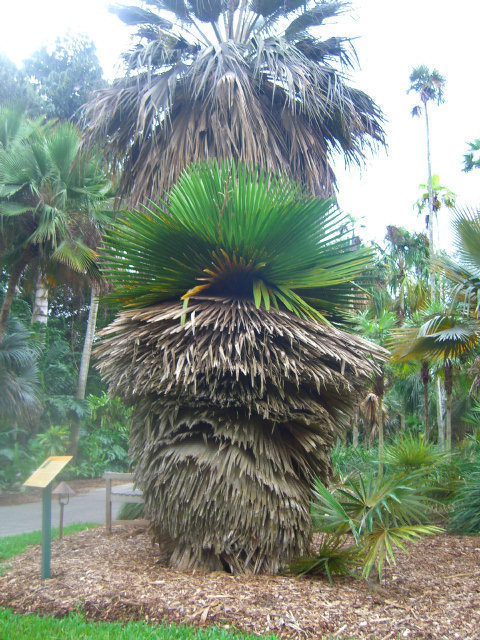Leave the Green: How to Prune Palms Properly

As published in the Miami Herald
As a palm lover, my favorite sight is a palm tree crown with a perfect circle of green leaves. The crown is full, strong, healthy and, my favorite, happy. In the wild, palms are not trimmed by man. Instead, they are allowed to keep their old leaves and shed them with time. While a full crown brings a smile to my face, palms missing many of their leaves make me grimace.
We have the power to maintain our palms in our yards however we choose. Sometimes, certain restrictions make it impossible to allow our palms to live in their natural state with all of their leaves. While trimming brown leaves is permissible, green leaves should never be pruned from the palm. Pruning green leaves steals nutrients from the palm, invites pests and diseases into the plant and can weaken the palm for hurricanes that are bound to visitSouth Florida.
Palms produce one new spear at a time from their center of growth, called the bud. Leaves move down through the canopy over time as new leaves take their place. As leaves move through the crown they give nutrients back to the bud. When the oldest leaves have reached the bottom of the crown, they will senesce and turn completely brown, giving all remaining nutrients back to the plant. The nutrients in the leaves provide energy for growth, acting as a food source. By taking away the green leaves before they naturally senesce, you are taking away much needed food for the palm.
 |
| Note the full crown of the European fan palm, Chamaerops humilis.This palm has a full lollipop shaped crown, the epitome of a healthy palm. |
By trimming green leaves, you are not only decreasing nutrients available to your palm, you are also inviting pests and diseases into the plant. Brown leaves are completely dead, while green leaves are alive. Pests and diseases are not drawn to dead palm tissue; they are attracted to green, living tissue. Trimming green leaves opens a fresh wound that calls pests to the feast. A palm infested with diseases caused by the trimming of green leaves can be much worse than a palm with a nutrient deficiency. If you are bothered by your nutrient deficiency, instead of trimming the living leaf, put down slow release8-2-12palm fertilizer. This will decrease the deficiency with time and patience. However, keep in mind that palm fertilization in the winter months is wasteful. Palms roots are unable to take up fertilizers due to cold soil temperature.
Pruning green leaves from your palms as a safety measure during hurricane season is oftentimes counterproductive, despite logical reasoning. By pruning green leaves, the palm is left altogether; stressed from missing leaves, hungry and probably infested with pests and diseases. Instead of helping the palm, the hurricane pruning has actually left the palm less prepared for the storm. Moreover, the bud, the center for growth, is now exposed to the full force of the storm. Since palms only have one center for growth, if the bud is seriously damaged, the palm will be unable to produce new leaves and will eventually die.
 |
| This Copernicia macroglassa, petticoat palm, retains its brown leaves and is home to a plethora of snakes, insects and lizards. |
While trimming brown leaves is not necessarily bad for your palm, leaving brown does have some obvious benefits. If you are a fan of wildlife, as most palm lovers are, the brown, dead leaves act as a safe haven for lizards, snakes and insects. All of these animals are yummy treats for birds, which will visit your yard in search of these delicacies. If you trim your palms yourself, save yourself the effort and energy. Put away the pole saw and clippers and spend time elsewhere in your garden. If you have a tree service, you can save money by not trimming brown leaves. You can use that money to buy another palm and create more habitats for happy snakes.
Next time you trim your palms, don’t look at your neighbor’s “feather duster” and copy it. Remember that a happy palm has a full crown of green leaves. Leaving the green leaves decreases nutrient deficiencies, decreases pest and disease infestations and creates a stronger palm to face the hurricane season. If you want to be a little radical, leave the brown leaves and invite wildlife to take refuge in your palm, which will result in saving both time and money. As I tell my volunteers, “Leave the green!”
